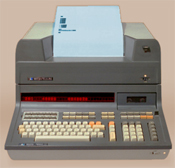![]() I read an iPhone app review on iTunes yesterday: ‘I’ve stopped using the Google Analytics website and just use the app…’ it claimed. It’s a big claim, given the extent of information Analytics provides. So I downloaded the app and gave it a try. And I had to agree…
I read an iPhone app review on iTunes yesterday: ‘I’ve stopped using the Google Analytics website and just use the app…’ it claimed. It’s a big claim, given the extent of information Analytics provides. So I downloaded the app and gave it a try. And I had to agree…
I have a theory about smartphone apps. I think they are changing our whole approach to mobile devices and shaping future computer operation.
The idea behind apps – application software – is beautifully simple. They are designed ‘to perform singular or multiple related specific tasks’ and ‘to help to solve problems in the real world’. They have been taking shape on personal computers for a good while, but their distillation to mobile devices (phone and tablets) brings a new focus to their efficiency, elegance and importance.
In the beginning…
Before high-level operating systems and application software, the use of computers – even the smartest, smallest and sexiest – was limited to those prepared to take on command-line working. In stark contrast to the ‘intuitive’ interfaces provided by a desktop and mouse, these meant you had to know your syntax. Small mistakes invited major failure. There were no menus to drop down; no icons to click on.

With the early-1970s Xerox research that enabled Apple to devise a ‘mouse and GUI’ approach (modelled on the early learning patterns of children), came new generations of personal computers that made sense to non-technical users. From business offices they spread to homes, and into schools, and into bedrooms. The apps that initially supported ‘office tasks’ like word processing and spreadsheets were joined by picture editors, illustration and design progams and desktop publishing. And games, games, games. Then came the internet and viruses.
The first smartphones promised more of the same, and made the internet mobile. But they had to work without the large screen, keyboard and mouse that desktop machines enjoy, and that made things tricky. Too tricky for a lot of applications, and very awkward for internet browsing.
But while genuine innovation is hard-won, refinement requires just another form of application.
We have all this great data…
Pinch technology made its debut at a TED talk given in 2006 by Jeff Han from the NYU Courant Institute of Mathematical Sciences. ‘The interface just disappears here…’ he says – more than once.
Equally significantly, he points out that ‘we have all this great data and we’re not really accessing it’. He could have been talking about that Analytics app.
Along with touchscreen technology and ‘touch and gesture’ technology from (now defunct) FingerWorks, pinch operation was key to the Apple's iPhone unlocking the small screen when it appeared in mid 2007.
Looking past the deluge of pointless novelty apps that belittle the power and significance of smartphones, successive iterations of ever more elegant apps are becoming the norm. Add in the introduction of the Apple iPad in mid 2010 – marrying the iPhone’s operational technology and use of apps with a larger screen – and the scent of revolution is in the air.
In a comparable move to Audio Video Bridging’s aim to simplify the design and operation of digital media networks, smartphones, tablet computers and apps are demanding that desktop computer software takes its next evolutionary step.
The secret of a great app design is not that it does something new, but that it takes available resources – internet information, processor power, GPS, Wi-Fi – and simplifies an otherwise difficult or laborious task. Or to ‘help to solve problems in the real world’. If a smartphone app can challenge a desktop app in its ability to access, order and navigate the volume of information offered by Google Analytics, it’s time to take the operation of personal computers and application specific DSP systems to a new level. And the first signs are here…
Alongside the AVB initiative, Symetrix is also showing the way to get smart. Plenty of manufacturers are releasing phone and tablet apps to aid support their equipment and systems, but Symetrix adopted an ‘app style’ approach to ts Jupiter audio processor, promising ‘zero learning curve’ operation. Now we’re talking.
Back on our desks, we look set to take the step from screen-and-mouse to touchscreen. Add in the app approach, and the obvious implication is that computers will no longer look nor ‘feel’ like the computers we use now. Technology developers and industrial designers couldn’t wish for a better opportunity to exercise their skills and imagination, or to define new ways of working and playing.
And I can’t wait to see what they come up with. How about you?


